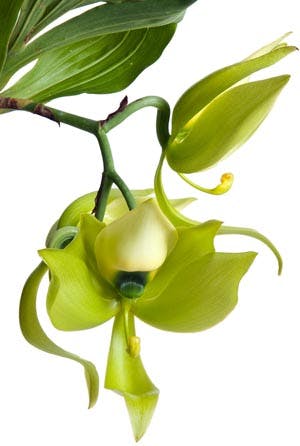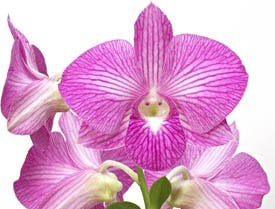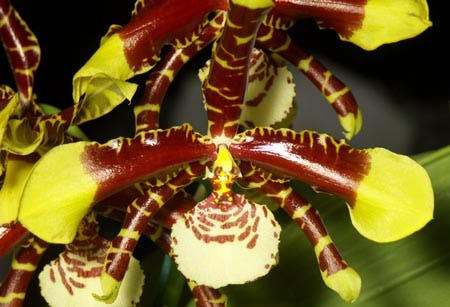Cattleya
Despite the shortening days and lowering angle of the sun, September can still be one of the hottest months. Water and fertilizer need to be in balance with heat and light. The alert grower will notice, however, that his or her plants are beginning to slow down a bit. Growths are maturing, and the sheaths are giving the promise of the next six-months' bloom.
Check plants for potting needs for the last time this season. Any in dire need should be potted, even some that may be on the cusp, as there is just enough of the growing season left to allow the plants to establish before the days start to get really short and cold.
This is the month for purples derived from Cattleya labiata breeding to flower. If you are short on flowers, look into this group. There is nothing that can quite match this type for beauty and fragrance. They are easy to grow, too.
Plants summered outdoors should begin to be prepared to be brought back into the winter growing area. Clean the plants up and be on the lookout for any pests they may have picked up during the summer. Treat as necessary.

Cycnoches chlorochilon, the green swan orchid.
Cycnoches
This little-known and under-appreciated genus, which can have male or female flowers, is at its best in the autumn. Two of the spectacular varieties are Cycnoches loddigesii, with its large brown flowers resembling a prehistoric bird, and Cycnoches chlorochilon, the swan orchid. This last one has large, fragrant green flowers. The biggest problem, culturally, will be red spider mite infestations that require immediate attention. Plants are quite seasonal, requiring heavy watering in the growing season and then a drier dormant winter season.
Cymbidium
Through diligent modern breeding programs, the cymbidium season gets stretched longer and longer. Now we can expect to have flowers open as early as September and October. Stake inflorescences and move the plants to a shadier location to help the flowers develop successfully. Because the plants will have warmth tolerance "built in" genetically, keeping the plants as cool as possible will help prevent bud curl. For the midseason varieties, inflorescences should be initiated by now. Feed plants on a regular schedule with a balanced fertilizer (20-20-20) and shade the plants lightly.

Dendrobium Burana Stripe is a popular and easy phalaenopsis-type hybrid.
Dendrobium
This is a good season for hybrids of the Dendrobium phalaenopsis and Dendrobium canaliculatum types. Both are capable of putting on tremendous shows of long-lasting flowers. Fertilize with a low-nitrogen formula to promote the best flowers. Dendrobium phalaenopsis can get tall and top heavy, suggesting an attractive and heavy container would be appropriate for this type.
Rhynchostele bictoniensis
Both Rhynchostele bictoniensis and its hybrids bloom in this season. Rhynchostele bictoniensis, formerly known as Lemboglossum, Odontoglossum) is a showy species from Mexico that has three different color forms: sulphureum (green with white lip), album (brown with white lip) and roseum (brown with a pink lip). It is a vigorous grower with tall inflorescences of many flowers, and imparts to its progeny (as seen in Odcdm. Bittersweet and Odm. bicross) ease of culture, warmth tolerance and eye-catching patterns. They make a prime candidate for odontoglossum beginners and advanced alike.
Paphiopedilum
Standard, green-leaved paphiopedilums begin to show their bloom sheaths this month. Late-season heat waves can blast these early sheaths, so be observant about proper cooling and air circulation. As with the rest of your plants that may have been summered outdoors, it is time to prepare for their move inside. Clean each plant and implement pest-control practices. Repotting, if necessary, is appropriate.
Phalaenopsis
The bulk of this season's growth is being ripened this month, with growers in cooler climates seeing the first emerging inflorescences. Some night heating may be necessary in the cooler areas. Begin to watch watering more carefully, and reduce feeding proportionately with reduced watering needs. An extra dose of phosphorus and potassium, such as a bloom-booster or high-acid-type fertilizer, is beneficial.

Rossioglossum grande shows off its large, dramatic flowers.
Rossioglossum grande
Once known as Odontoglossum grande, this is a spectacular orchid with six to eight flowers up to 8 inches across. Often known as the tiger orchid, it has bright golden yellow flowers heavily marked with chestnut brown barring. The plants are beautiful with a grey-green cast to the foliage, which is borne on succulent pseudobulbs. It prefers hot and wet summers with cooler, even down to 40 F, dry winters. Grow under filtered light. Watch for snails and slugs that eat the flowers, pseudobulbs and leaves.
The AOS thanks Ned Nash and James Rose for this essay.








